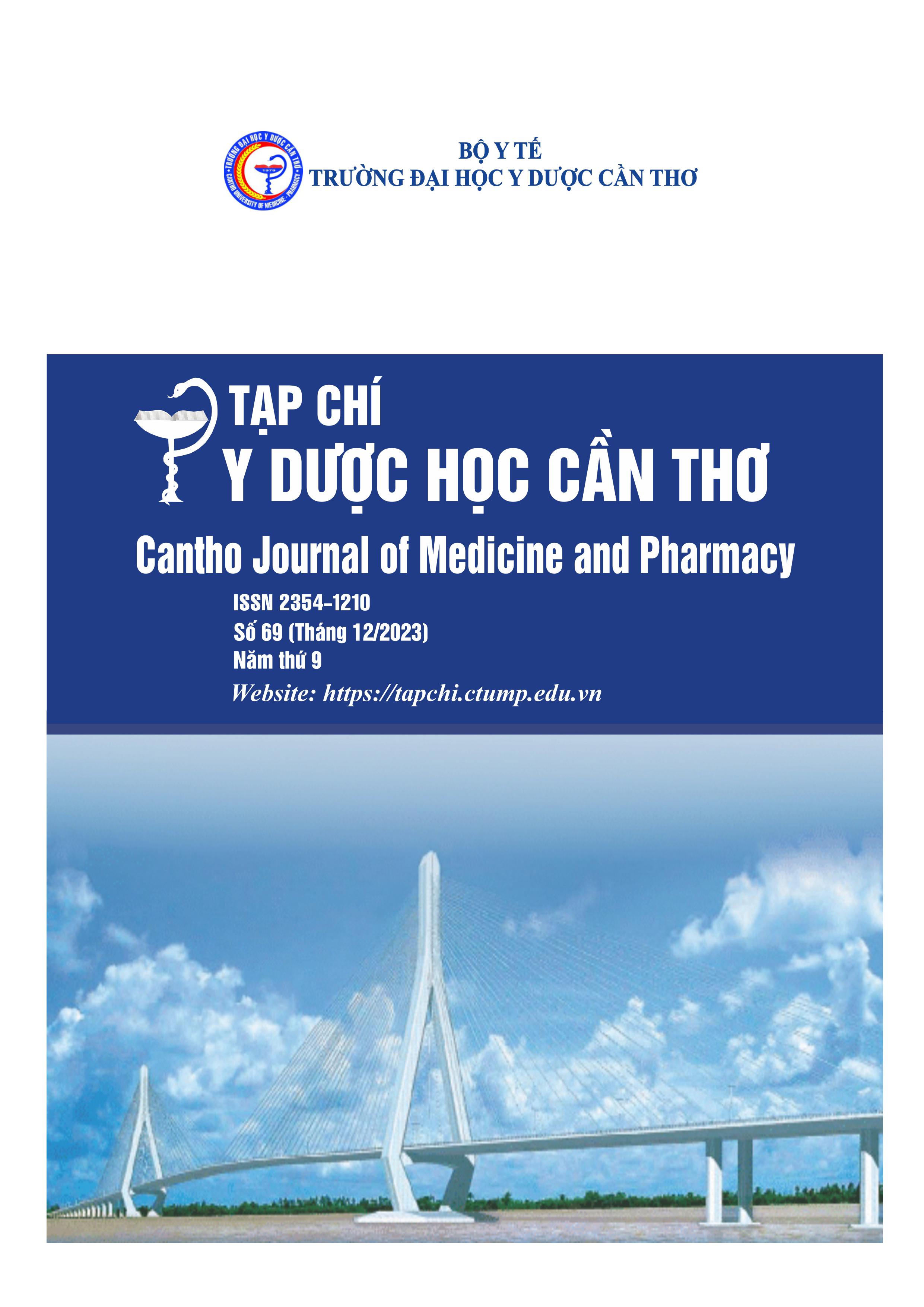THE EPIDEMIOLOGICAL FACTORS, CLINICAL AND LABORATORY FEATURES OF MULTISYSTEM INFLAMMATORY SYNDROME IN CHILDREN (MIS-C) INFECTED WITH SARS-CoV-2 AT CAN THO CHILDREN'S HOSPITAL
Main Article Content
Abstract
Background: Multisystem inflammatory syndrome (MIS-C) is a rare but serious medical condition that usually occurs 2–6 weeks after SARS-CoV-2 infection. MIS-C is characterized by inflammation in several organ systems including the cardiovascular, respiratory, mucosal and gastrointestinal systems and the etiology of MIS-C remains unknown. Despite the severity of MIS-C , the study of epidemiological factors, clinical and laboratory features helps to provide data and improve treatment effectiveness. Objectives: To do research on the epidemiological factors, clinical and laboratory features of Multisystem Inflammatory Syndrome in Children infected with SARS-CoV-2 (MIS - C) at Can Tho Children's Hospital. Materials and methods: This was a retrospective study of 58 patients diagnosed with MIS-C treated at Can Tho Children's Hospital (from September 2021 to September 2022). Results: A total of 58 patients were included (median age, 5,47 years old, 2 months – 13 years), 69% of cases were male, the median time from COVID-19 to onset of MIS-C-related symptoms was 6,63 weeks with average hospital stay was 11 days . All 58 patients had fever with a mean duration of fever of 7,14 days. Skin rash appeared the most with 81%, mucosal changes with strawberry tongue symptoms accounted for 34,5%, red lips with 63,8%, loose stools with 27,6%, 28/58 patients had limb edema (41,4%), neck lymph node with 8,6%, 10/58 patients had shock (17,2%). Patients with the increase in white blood cells accounted for 48,3%, the increased platelets with 10,3%, 51 patients did CRP with median value of 122,9 mg/L, Procalcitonin had 36 (97.2%) patients tested for concentration with an average value of 34,31 ng/mL, 45 patients was recorded with median Ferritin value of 411000 µ/L, mean D-dimmer value observed in 49 patients with 7,05 µg/ml, Fibrinogen was performed in 52 cases with a median value of 5,29 g/L, echocardiography in 55 patients had 13/55 cases of coronary vasodilation (22,4%) including 7 cases of left coronary artery dilation and 6 cases of dilatation of both coronary arteries. There was a significant difference in the shock condition with the level of ferritin (p=0,037) and difference between coronary artery dilation and platelet count (p=0,018), as well as the correlation between procalcitonin levels and the length of hospital stay (p=0,027). Oral or oropharyngeal findings were associated significantly with the presence of skin rash (p=0,008) and conjunctivitis (p=0,001). Conclusion: The most typical organ injury in MIS-C was mucocutaneous. Higher levels of ferritin increased the risk of shock and elevated platelet counts increased the ability to get coronary artery dilation in patients with MIS-C. Those with higher procalcitonin levels at admission were found to stay longer in the hospital. The presence of oral or oropharyngeal changes might be an early indicator of MIS-C and should be considered suggestive of MIS-C in the setting of COVID-19 infection.
Keywords: Epidemiological factors, clinical features, laboratory features, MIS-C.
Article Details
Keywords
Epidemiological factors, clinical features, laboratory features, MIS-C
References
2. Phung, N.T.N., et al. Cardiovascular injury and clinical features of multisystem inflammatory syndrome in children (MIS-C) related to Covid-19 in Vietnam, Pediatrics & Neonatology. 2022, 63(6), 569-574, doi: 10.1016/j.pedneo.2022.05.009.
3. Ahmed, M., et al. Multisystem inflammatory syndrome in children: a systematic review, EClinicalMedicine. 2020. 26, 100527, doi: 10.1016/j.eclinm.2020.100527.
4. Belhadjer, Z., et al. Acute Heart Failure in Multisystem Inflammatory Syndrome in Children in the Context of Global SARS-CoV-2 Pandemic, Circulation. 2020, 142(5), 429-436, doi: 10.1161/CIRCULATIONAHA.120.048360
5. Feldstein, L.R., et al. Multisystem inflammatory syndrome in US children and adolescents, New England Journal of Medicine. 2020, 383(4), 334-346, doi: 10.1056/NEJMoa2021680.
6. Cheung, E.W., et al. Multisystem inflammatory syndrome related to COVID-19 in previously healthy children and adolescents in New York City, Jama. 2020, 324(3), 294-296, doi: 10.1001/jama.2020.10374.
7. Miller, J., et al. Gastrointestinal symptoms as a major presentation component of a novel multisystem inflammatory syndrome in children that is related to coronavirus disease 2019: a single center experience of 44 cases, Gastroenterology. 2020, 159(4), 1571-1574. e2, doi: 10.1053/j.gastro.2020.05.079.
8. Halepas, S., et al. Oral manifestations of COVID-2019–related multisystem inflammatory syndrome in children: a review of 47 pediatric patients, The Journal of the American Dental Association. 2021, 152(3), 202-208, doi: 10.1016/j.adaj.2020.11.014.
9. Pouletty, M., et al. Paediatric multisystem inflammatory syndrome temporally associated with SARS-CoV-2 mimicking Kawasaki disease (Kawa-COVID-19): a multicentre cohort, Annals of the rheumatic diseases. 2020, 79(8), 999-1006, doi: 10.1136/annrheumdis-2020-217960.
10. Whittaker, E., et al. Clinical characteristics of 58 children with a pediatric inflammatory multisystem syndrome temporally associated with SARS-CoV-2, Jama. 2020, 324(3), 259-269, doi: 10.1001/jama.2020.10369.
11. Haslak, F., et al. Clinical features and outcomes of 76 patients with COVID-19-related multisystem inflammatory syndrome in children, Clin Rheumatol. 2021, 40(10), 4167-4178, doi: 10.1007/s10067-021-05780-x.


